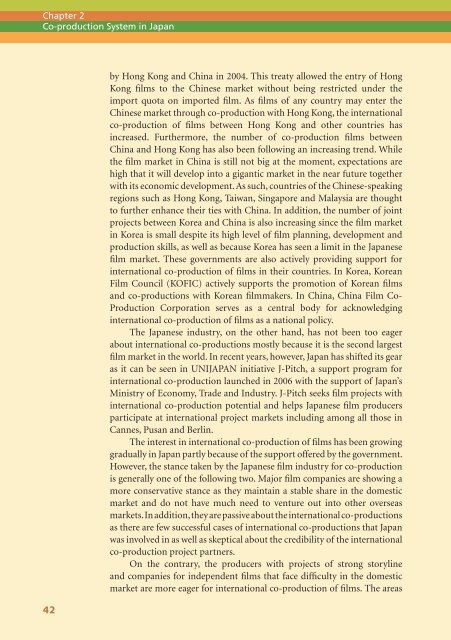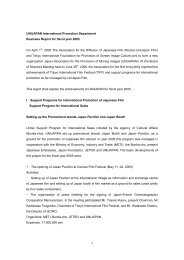The Guide to Japanese Film Industry & Co -Production - UNIJAPAN
The Guide to Japanese Film Industry & Co -Production - UNIJAPAN
The Guide to Japanese Film Industry & Co -Production - UNIJAPAN
You also want an ePaper? Increase the reach of your titles
YUMPU automatically turns print PDFs into web optimized ePapers that Google loves.
Chapter 2<br />
<strong>Co</strong>-production System in Japan Development of <strong>Co</strong>-production System and Its Structure<br />
by Hong Kong and China in 2004. This treaty allowed the entry of Hong<br />
Kong films <strong>to</strong> the Chinese market without being restricted under the<br />
import quota on imported film. As films of any country may enter the<br />
Chinese market through co-production with Hong Kong, the international<br />
co-production of films between Hong Kong and other countries has<br />
increased. Furthermore, the number of co-production films between<br />
China and Hong Kong has also been following an increasing trend. While<br />
the film market in China is still not big at the moment, expectations are<br />
high that it will develop in<strong>to</strong> a gigantic market in the near future <strong>to</strong>gether<br />
with its economic development. As such, countries of the Chinese-speaking<br />
regions such as Hong Kong, Taiwan, Singapore and Malaysia are thought<br />
<strong>to</strong> further enhance their ties with China. In addition, the number of joint<br />
projects between Korea and China is also increasing since the film market<br />
in Korea is small despite its high level of film planning, development and<br />
production skills, as well as because Korea has seen a limit in the <strong>Japanese</strong><br />
film market. <strong>The</strong>se governments are also actively providing support for<br />
international co-production of films in their countries. In Korea, Korean<br />
<strong>Film</strong> <strong>Co</strong>uncil (KOFIC) actively supports the promotion of Korean films<br />
and co-productions with Korean filmmakers. In China, China <strong>Film</strong> <strong>Co</strong>-<br />
<strong>Production</strong> <strong>Co</strong>rporation serves as a central body for acknowledging<br />
international co-production of films as a national policy.<br />
<strong>The</strong> <strong>Japanese</strong> industry, on the other hand, has not been <strong>to</strong>o eager<br />
about international co-productions mostly because it is the second largest<br />
film market in the world. In recent years, however, Japan has shifted its gear<br />
as it can be seen in <strong>UNIJAPAN</strong> initiative J-Pitch, a support program for<br />
international co-production launched in 2006 with the support of Japan’s<br />
Ministry of Economy, Trade and <strong>Industry</strong>. J-Pitch seeks film projects with<br />
international co-production potential and helps <strong>Japanese</strong> film producers<br />
participate at international project markets including among all those in<br />
Cannes, Pusan and Berlin.<br />
<strong>The</strong> interest in international co-production of films has been growing<br />
gradually in Japan partly because of the support offered by the government.<br />
However, the stance taken by the <strong>Japanese</strong> film industry for co-production<br />
is generally one of the following two. Major film companies are showing a<br />
more conservative stance as they maintain a stable share in the domestic<br />
market and do not have much need <strong>to</strong> venture out in<strong>to</strong> other overseas<br />
markets. In addition, they are passive about the international co-productions<br />
as there are few successful cases of international co-productions that Japan<br />
was involved in as well as skeptical about the credibility of the international<br />
co-production project partners.<br />
On the contrary, the producers with projects of strong s<strong>to</strong>ryline<br />
and companies for independent films that face difficulty in the domestic<br />
market are more eager for international co-production of films. <strong>The</strong> areas<br />
and genres of involvement is also starting <strong>to</strong> expand, including investment<br />
<strong>to</strong> the direc<strong>to</strong>rs of artistic films such as Jia Zhang Ke (China), Abbas<br />
Kiarostami (Iran) and Kim Ki-Duk (Korea), as well as entertainment films<br />
such as A Battle of Wits and Red Cliff.<br />
3. Trying <strong>to</strong> Define International <strong>Co</strong>-production<br />
<strong>The</strong>re is no clear-cut definition of international co-production in Japan.<br />
J-Pitch program recognizes projects as international co-productions if<br />
there is the participation of more than one country <strong>to</strong> invest in the film<br />
and the participation of a <strong>Japanese</strong> producer in the project. In Japan<br />
international co-productions take on various forms and a number of fac<strong>to</strong>rs<br />
must be considered and included when creating its definition. <strong>The</strong>se fac<strong>to</strong>rs<br />
would be for instance, co-production of several countries, investment of<br />
several countries in a well-known direc<strong>to</strong>r or in a project which surely has<br />
a potential of becoming a success. In the past, Oshima Nagisa directed In<br />
the Realm of the Senses with the investment of a French company. Both the<br />
cast and crew were <strong>Japanese</strong>, but the film nationality was French. Oshima<br />
has since directed a number of international co-productions including<br />
Max mon amour and Merry Christmas Mr. Lawrence. Similarly, Kurosawa<br />
Akira has also directed such works as Dersu Uzala, Ran and Dreams with<br />
investments from several countries. <strong>The</strong>se are cases of international capital<br />
investment <strong>to</strong> allow the esteemed direc<strong>to</strong>rs of Japan <strong>to</strong> shoot films, but<br />
there are many other works that have been produced as international coproduction.<br />
4. Works Recognized as <strong>Co</strong>-production in Japan<br />
Three Patterns and Recent Cases<br />
¡Pattern 1: Producers, cast and crew from several countries are involved in a film<br />
invested by those countries.<br />
list of recent major works<br />
A Battle of Wits 2006; invested by China, Hong Kong, Korea and Japan;<br />
cast includes Chinese, Korean and Hong Kong ac<strong>to</strong>rs<br />
Crossing Over 2007; invested by China and Japan;<br />
cast includes Nakai Kiichi and Miao Pu<br />
Dream 2008; invested by Korea and Japan;<br />
cast includes Odagiri Joe<br />
hana kage 2007; invested by Japan and Korea;<br />
cast includes Kim Rae Won and Yamamo<strong>to</strong> Mirai<br />
Last Life in the Universe 2003; invested by Thailand, the Netherlands, France, Singapore<br />
and Japan; starring Asano Tadanobu<br />
42 43




